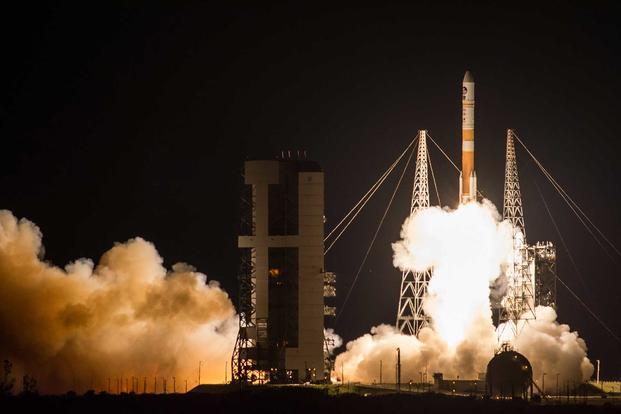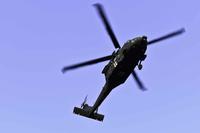Lawmakers have signed off on a plan to give President Donald Trump his much-anticipated U.S. Space Force. But the plan would prevent the military's new sixth branch from making new hires in the beginning, limiting redundancy and bureaucratic bloat, according to the final version of the National Defense Authorization Act for fiscal 2020.
Congress has moved forward with a proposal made last year to place the Space Force under the Department of the Air Force, and budgeted $72.4 million for stand-up costs, according to the legislation.
But the newly established service will be required to use existing personnel, specifically from Air Force Space Command, to jump-start the initiative, said Todd Harrison, director of the Aerospace Security Project at the Center for Strategic & International Studies, a think tank in Washington, D.C.
"What it forces the Air Force to do is actually transfer all of [its] people," he said in an interview Tuesday, adding that the provision is a significant step to leverage those in space positions already at AFSPC in Colorado Springs, Colorado. "That will be the nucleus of the Space Force."
Related: Key Lawmaker 'Glowing' About Final Plan for Space Force
Key lawmakers have said they intend to keep the Space Force small and will monitor its creation and the hiring of any additional mission-essential personnel down the line.
"The biggest concern is maximizing efficiency, minimize the amount of money spent. We don't need to create a whole bunch of more positions," chairman of the House Armed Services Committee Rep. Adam Smith, D-Wash., told reporters Saturday during the Reagan National Defense Forum.
In a CSIS study conducted last year, Harrison championed redistribution of personnel to save taxpayer dollars.
"All of those billets just need to move and become the Space Force headquarters," he said. "It's actually a pretty smart move that [Congress] made to prevent bureaucratic growth."
The House is expected to vote on the bill, unveiled Monday, this Wednesday, with the Senate to follow later this month.
During its first year, the Space Force will establish a headquarters and plan for the future with the branch's core functions in mind: "protect the interests of the United States in space; deter aggression in, from, and to space; and conduct space operations," according to the bill.
Under the measure, the president may appoint a general to become the "Chief of Space Operations," reporting to the secretary of the Air Force and sitting as a member of the Joint Chiefs of Staff. He or she may serve in that capacity no more than four years, but could be extended to eight years in a time of war or during a national emergency, the bill states.
As lawmakers and the Pentagon debated the new position over the past few months, it had different names, including chief of staff, commandant and commander, Harrison said.
"They instead chose this fourth name and went with something kind of like the Navy. Instead of chief of naval operations, the chief of the Space Force will be the chief of space operations," he said. "If anything, they're kind of signaling that maybe [this] will be more of a Navy-like ... structure for the Space Force than an Air Force structure."
To get started the first year, the U.S. Space Command commander may also serve as the new Chief of Space Operations, according to the bill. Currently, Gen. John "Jay" Raymond leads U.S. Space Command, as well as Air Force Space Command at Peterson Air Force Base, Colorado.
The new chief, along with the Air Force secretary, must brief lawmakers every 60 days until at least March 31, 2023, on the status of the new branch's implementation, the bill states.
The legislation also creates a Senate-confirmed assistant secretary of the Air Force for Space Acquisition and Integration to oversee the purchase of space equipment.
In May, senators nixed one of the Pentagon's proposals to create a civilian position -- the under secretary of the Air Force for space -- who would work alongside a top general. Lawmakers said an additional civilian authority in the chain of command would create bureaucratic roadblocks.
"The House and the Senate and the White House all got some things they wanted, having to compromise on everything," Harrison said. "They struck up a middle-of-the-road compromise."
Despite the Pentagon's rush to stand up the service after Trump called for the branch in 2018 to deter malign actors in space, some view the Space Force as a catalyst to violate treaties or international agreements.
"At best, a space force is a distraction from what is necessary to ensure space security in the face of rapid technological and geopolitical changes," Laura Grego, a physicist and senior scientist in the Global Security Program for the Union of Concerned Scientists, said in a statement Tuesday. "At worst, it would prompt a space arms race that would threaten U.S. military and civilian satellites, not protect them.
"Diplomacy, not bureaucratic reorganization, is urgently needed."
-- Oriana Pawlyk can be reached at oriana.pawlyk@military.com. Follow her on Twitter at @Oriana0214.
Read more: Congress Has Released Its $738 Billion Defense Budget. Here's What's Inside











